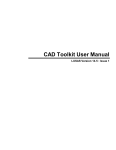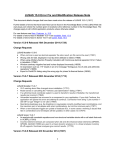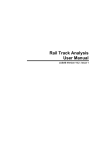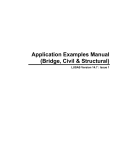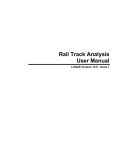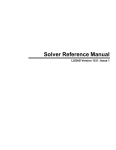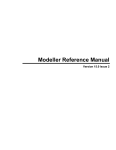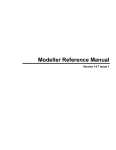Download Calculation of spring constants for use as spring supports in LUSAS
Transcript
CUSTOMER SUPPORT NOTE The design of volume and surface layouts in Version 13 to ensure mesh connectivity Note Number: CSN/LUSAS/1003 This support note is issued as a guideline only. © Finite Element Analysis Ltd. 2005 © Finite Element Analysis Ltd 2005 CSN/LUSAS/1003 Table of Contents 1. INTRODUCTION 1 2. DESCRIPTION - VOLUMES 1 3. DESCRIPTION – SURFACES 6 CSN/LUSAS/1003 1. Introduction Many users experience problems when creating geometries for solid and surface modelling to ensure automatic mesh connectivity. This support note outlines the procedure necessary and highlights common user errors which must be avoided. 2. Description - Volumes When creating solid models using volumes it is important that each volume connects to other volumes via its surfaces. Therefore two connected volumes will share a common surface. A common mistake is to create volumes which are unconnected which then results in unconnected elements. It is possible to place two volumes next to each other with no common surface but in this situation a tied slideline must be used to join the surfaces together. Advice on using tied slidelines can be found in the LUSAS User Manual and is beyond the scope of this Customer Support Note. The use of tied slidelines should be avoided unless absolutely necessary. To illustrate the procedure consider two 6 sided rectangular blocks, the smaller being positioned on top of the larger. Y X Z Figure 1: Two geometric volumes A temptation is to simply assign a solid mesh to each volume and create a situation as shown below. This example has used a default mesh division of 4 for each line. Page 1 CSN/LUSAS/1003 © Finite Element Analysis Ltd 2005 Y X Z Figure 2: Solid mesh applied to two volumes It can clearly be seen that there is a discontinuity in the solid finite element mesh between the two volumes which will lead to an error when running the analysis. Therefore the larger volume should be split up into smaller volumes, with a central volume existing which shares its top-most surface with the bottom surface of the smaller volume. The simplest method to do this would be to sweep the bottom surface of the smaller volume down through the larger block to create the central volume and then connect the corners of the larger block to the corners of the central volume. Once all the necessary lines have been created surfaces can be constructed and then these surfaces used to create four further volumes within the larger block. Meshing all six volumes using this method will lead to the following geometric and mesh layout respectively. Page 2 CSN/LUSAS/1003 © Finite Element Analysis Ltd 2005 Y X Z Figure 3: Geometric layout for 6 volume method Y X Z Figure 4: Mesh layout from 6 volume method It can now be seen that the elements at the base of the smaller volume tie-up with the central elements at the top of the larger volume. Page 3 CSN/LUSAS/1003 © Finite Element Analysis Ltd 2005 This method is adequate however it leads to elements which increase in size towards the edge of the larger volume. If this is unwanted and a regular element size is preferred then the alternative method outlined below should be used which involves splitting the larger block into nine smaller volumes. A central volume is created as before by sweeping the base of the smaller volume through the larger block as before. Four further volumes are then created by sweeping the vertical surfaces of the central volume out towards the edge of the large block and the remaining four corner volumes are created as necessary. The geometric and mesh layout respectively is shown below. Y X Z Figure 5: Geometric layout for 10 volume method Page 4 CSN/LUSAS/1003 © Finite Element Analysis Ltd 2005 Y X Z Figure 6: Mesh layout for 10 volume method As shown above the finite element meshes from both blocks tie-up and a regular mesh is used throughout. This would be the preferred method of the two outlined. Page 5 CSN/LUSAS/1003 © Finite Element Analysis Ltd 2005 3. Description – Surfaces A similar process is required when creating surface models. It is important that each surface connects to other surfaces via common lines. There should be no overlapping lines from adjacent surfaces, when two surfaces connect each surface should share the common line in its definition. Unconnected surfaces will lead to unconnected meshes as for volumes. Tied meshes can be used to join surfaces which do not share a common line but this method is not advised and should be avoided if possible. Further advice on the use of tied meshes can be found in the LUSAS User Manual. To illustrate the procedure required for surfaces consider three rectangles as shown. Y Z X Figure 7: Three geometric surfaces Again the temptation is to mesh each surface separately as shown below but that would create a mesh discontinuity. The example below has used a default mesh division of 4 for each line. Page 6 CSN/LUSAS/1003 © Finite Element Analysis Ltd 2005 Y Z X Figure 8: Surface mesh applied to three surfaces A mesh such as the above will generate errors when running the analysis and so the surfaces should be modified to ensure the mesh connects together correctly. The simplest method would be to delete the surfaces and then create them again from smaller surfaces ensuring that a corner of one surface meets the corner of another surface and connecting lines between surfaces are shared; there should be no overlapping lines in the model using this method. As shown below the resulting geometry consists of six smaller surfaces and the assigned mesh is now fully connected throughout the model. Page 7 CSN/LUSAS/1003 © Finite Element Analysis Ltd 2005 Y Z X Figure 9: Geometry and mesh layout after splitting surfaces. An alternative method would be to use combined line features. This has the advantage in that the surfaces do not require splitting into smaller surfaces but is generally considered more of an advanced technique and beginners are encouraged to use the method outlined above. Combined lines can be created from two or more lines which form the side of one surface. The surface should then be created using the combined line as well as the other lines from the sides of the surface. Again there should be no overlapping lines in the model. Combined lines can be created by selecting the lines to combine and carrying out the menu command Geometry > Line > Combined line > Lines. This has been carried out for the example above as shown below. Page 8 CSN/LUSAS/1003 © Finite Element Analysis Ltd 2005 Y Z X Figure 10: Geometry layout after combining lines Surfaces can then be created using the combined lines and ordinary lines. When assigning a mesh using this technique null line mesh divisions should be assigned to the lines to ensure correct mesh connectivity. In this example a null line mesh division of 12 has been assigned to the left side of the large square which matches with the three line divisions of 4 on the opposite side. A null line mesh division of 5 has been assigned to the top right-hand line and a division of 1 assigned to the shorter of the two lines on the opposing side of the surface. The result is as follows. Page 9 CSN/LUSAS/1003 © Finite Element Analysis Ltd 2005 Y Z X Figure 11: Mesh layout after using the combined line method This results in a mesh which is fully connected but is not as regular as the first method. Page 10












